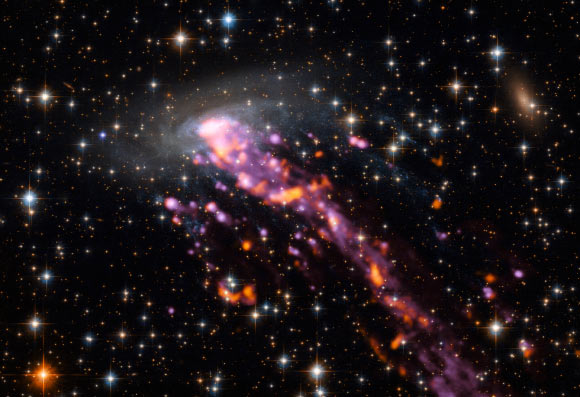Astronomers Get Closer Look at Norma Jellyfish Galaxy | Astronomy – Sci-News.com
Astronomers using the Atacama Large Millimeter/submillimeter Array (ALMA) have mapped the intense tail of a barred spiral galaxy called ESO 137-001, also known as the ‘Norma jellyfish galaxy.’

ESO 137-001 is a textbook example of a galaxy that is undergoing stripping by ram pressure: the galaxy and its surroundings were imaged by Hubble; its tail, which traces streams of hydrogen and show up in hues of bright purple, by the MUSE instrument mounted on the VLT; and bright hotspots of carbon dioxide emission from within the system, which show up as flares of orange-red, were spotted by ALMA. Image credit: ALMA / ESO / NAOJ / NRAO / P. Jachym et al.
ESO 137-001 is located in the southern constellation of Triangulum Australe, in the heart of the galaxy cluster Abell 3627.
Also known as the Norma Cluster, Abell 3627 is a group of galaxies near the center of the Great Attractor, a region of space that earned its name by being so massive. The cosmic structure resides approximately 200 million light-years from Earth.
ESO 137-001 is undergoing a strong interaction with the surrounding medium and is one of the nearest ‘jellyfish galaxies’ with a long tail.
Its tail, some 260,000 light-years in length, is caused by a dramatic phenomenon known as ram-pressure stripping.
“The space between galaxies in a galaxy cluster is not empty, but full of material that acts like a viscous fluid,” the astronomers explained.
“As a galaxy travels through this resistant environment, gas is stripped out of the galaxy to form a wake that creates beautiful, intricate systems such as that seen around ESO 137-001.”
“The direction and position of the tail shed light on the way in which the galaxy is moving — with galaxies usually falling towards the center of the cluster itself.”
The researchers used ALMA to create the high-resolution map of the cold molecular gas lurking within the ESO 137-001 tail.
They found a rich distribution of compact regions of carbon monoxide extending to nearly 196,000 light-years in length and 81,500 light-years in width. In total, about one billion solar masses of molecular gas were detected.
The carbon monoxide features were found predominantly at the heads of numerous small-scale fireballs (star-forming clouds with linear streams of young stars extending toward the galaxy), but also of large-scale super-fireballs, and double-sided fireballs.
“The ALMA observations of ESO 137-001, together with observations from the NASA/ESA Hubble Space Telescope, NASA’s Chandra X-ray Observatory and the MUSE instrument mounted on ESO’s Very Large Telescope (VLT), offer the most complete view of a spectacular ram pressure stripped tail to date,” the scientists said.
They detailed their findings online in a paper submitted to the Astrophysical Journal.
_____
Pavel Jachym et al. 2019. ALMA unveils widespread molecular gas clumps in the ram pressure stripped tail of the Norma jellyfish galaxy. ApJ, in press; arXiv: 1905.13249






